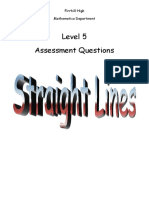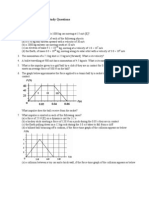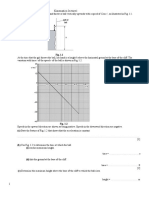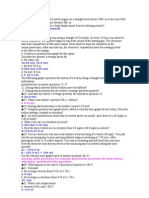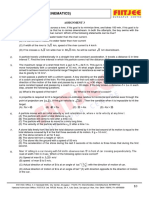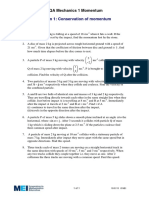Using Vectors Exercise PDF
Uploaded by
wolfretonmathsUsing Vectors Exercise PDF
Uploaded by
wolfretonmathsAQA Mechanics 1 Kinematics in two dimensions
Section 1: Using vectors
Exercise
1. Write as a single vector
(i) AB BC
(ii) PQ RQ
(iv) AC BC BD
(iii) AB BC CD
(v) PQ SR RQ
2. ABCD is a rectangle. Decide whether the following statements are true or false.
(i) AB CD
(ii) AB BC AD DC
3. The diagonals of a parallelogram ABCD intersect at M. If AB p and AD q ,
express in terms of p and q the vectors
(i) BD
(ii) AM
(iii) AC
(iv) MD
4. a, b and c are vectors representing displacements such that a represents 2 km due
north, b represents 1 km north west and c represents 2 km due west. Find the
magnitudes and directions of
(i) 2a
(ii) 4b
(iii) -a
(iv) a + b
(v) b - c
5. If AB = 2i j, BC = 3i + 4j and AD = i + 5j, ABCD is a quadrilateral and M is
the mid point of CD, express in terms of i and j the vectors
(i) AC
(ii) CD
(iii) DB
(iv) AM
(v) DM
6. Find the components of each of the vectors below in the directions Ox and Oy.
(i) Vector a has magnitude 10 and makes an angle of 50 with the positive
direction Ox.
(ii) Vector b has magnitude 8 and makes an angle of 125 with the positive
direction Ox.
(iii)Vector c has magnitude 4 and makes an angle of -80 with the positive
direction Ox.
7. A particle accelerates at a constant rate from an initial velocity of 3i j to a
final velocity of 5i 3j over 2 seconds. Find the acceleration of the particle.
8. A particle has initial velocity 2i 3j and acceleration of i j . Find
(i) the velocity of the particle after 5 seconds
(ii) the displacement of the particle after this time.
9. A particle moves from point A, which has position vector 3i 5 j , to point B,
which has position vector 7i j . When it is at A, it is moving with velocity
i 2 j . The journey from A to B takes 4 seconds.
(i) Find the acceleration of the particle.
(ii) Find the speed of the particle when it reaches B.
1 of 2
10/01/13 MEI
AQA M1 Kinematics in 2D Exercise
10. An aeroplane heads due south with a velocity of 300 kmh-1. It is being blown by a
wind with velocity 45 kmh-1 from a bearing of 250. Find the velocity of the
aeroplane relative to the ground.
11. A canal has straight parallel banks 100 m apart. A man rows a boat at 4 ms -1 in a
direction perpendicular to the banks. If the canal flows at 1.2 ms-1, find the
magnitude of the resultant velocity of the boat and the distance downstream that
the boat is carried as it crosses from one side to the other.
12. A boy sailing a boat wishes to land on Treasure Island which is due west of his
current position. There is a current of 3 kmh-1 flowing from S 28 E. The boy
knows that in still water his boat can reach 10 kmh-1. What course should he steer
to reach the island?
2 of 2
10/01/13 MEI
You might also like
- Using Parametric Equations - Solutions PDFNo ratings yetUsing Parametric Equations - Solutions PDF4 pages
- 9702 - p1 - Kinematics - All (Finished Upto May-June 2012)No ratings yet9702 - p1 - Kinematics - All (Finished Upto May-June 2012)42 pages
- 02 Momentum & Energy Extra Study Questions50% (2)02 Momentum & Energy Extra Study Questions141 pages
- Worksheet #1g: Hydrostatic Pressure & Archimedes' PrincipleNo ratings yetWorksheet #1g: Hydrostatic Pressure & Archimedes' Principle3 pages
- NCERT Solutions For Class 9 Science Chapter 8 MotionNo ratings yetNCERT Solutions For Class 9 Science Chapter 8 Motion21 pages
- Rectilinear-Figures Important-Qs Important-QuestionsNo ratings yetRectilinear-Figures Important-Qs Important-Questions2 pages
- TARGET: JEE (Main + Advanced) 2017 Course: VIKAAS (JA)No ratings yetTARGET: JEE (Main + Advanced) 2017 Course: VIKAAS (JA)15 pages
- Unit 5 Motion of System of Particles and Rigid BodyNo ratings yetUnit 5 Motion of System of Particles and Rigid Body8 pages
- Uace Mathematics Paper 2 2011 and Marking GuideNo ratings yetUace Mathematics Paper 2 2011 and Marking Guide12 pages
- Amrita: Amrita Entrance Examination - EngineeringNo ratings yetAmrita: Amrita Entrance Examination - Engineering17 pages
- Topic 5 - Electricity and Magnetism - IB PhysicsNo ratings yetTopic 5 - Electricity and Magnetism - IB Physics18 pages
- Review Answer Key Graphingsolving Rational Equations Test CNo ratings yetReview Answer Key Graphingsolving Rational Equations Test C4 pages
- 10th Trigonometry Identities Test Paper-2No ratings yet10th Trigonometry Identities Test Paper-23 pages
- Net Force: Physics 11 M. Lam Name: BlockNo ratings yetNet Force: Physics 11 M. Lam Name: Block2 pages
- SR_NEET_STAR_SUPER_CHAINA_NEET_SPECIAL_TEST_3_Q_P_EX_DT_07_04_2024No ratings yetSR_NEET_STAR_SUPER_CHAINA_NEET_SPECIAL_TEST_3_Q_P_EX_DT_07_04_202424 pages
- CLS JEEAD-19-20 XI Phy Target-1 Level-1 Chapter-1 PDFNo ratings yetCLS JEEAD-19-20 XI Phy Target-1 Level-1 Chapter-1 PDF21 pages
- Chapter 6: Wave: 6.1 Understanding WavesNo ratings yetChapter 6: Wave: 6.1 Understanding Waves35 pages
- Electrostatic Field: Electromagnetic Fields & WavesNo ratings yetElectrostatic Field: Electromagnetic Fields & Waves64 pages
- Using Partial Fractions in Integration Exercise PDFNo ratings yetUsing Partial Fractions in Integration Exercise PDF1 page
- Vectors in Two & Three Dimensions Exercise PDFNo ratings yetVectors in Two & Three Dimensions Exercise PDF2 pages






